Now Reading: Top 10 Best Places Visiting in Dakshina Kannad for Culture, Nature & Coastal Charm
-
01
Top 10 Best Places Visiting in Dakshina Kannad for Culture, Nature & Coastal Charm

Top 10 Best Places Visiting in Dakshina Kannad for Culture, Nature & Coastal Charm
1.Mangala Devi Temple

A sacred temple known as Mangala Devi stands in vibrant Mangaluru Karnataka since the tenth century. The temple’s presiding deity Goddess Mangaladevi provides the city its name since Mangaluru derived from the temple.
History
The Mangala Devi Temple exists today because of its connections to the legendary sage Parashurama as well as the Malabar princess Mangala Devi. Historical records indicate that the Alupa dynasty built the temple during the 10th century thus linking it directly to the significant religious background of the area.
Significance
The temple pays homage to Goddess Mangaladevi who appears as an incarnation of Goddess Durga so devotees come here to receive blessings that enhance prosperity and health. Every year Navaratri festival obtains dedicated celebrations through which pilgrims travel from different parts of the region.\
2.Kadri Manjunatha Temple

Karnataka features the Kadri Manjunatha Temple at Kadri Hill in Mangaluru as its most important and historically important temple. The ancient temple which was built during the 11th century merges sacred religious traditions with architectural excellence and natural landscape attributes.
History
Local believers view the Kadri Manjunatha Temple as having strong Buddhist origins. A bronze image showing Lokeshwara alongside Gautama Buddha in the Dhyani posture proves that this place first served Buddhist worship. A transition occurred throughout time before becoming a key Shaivite center which continues today to preserve multiple religious traditions and backgrounds.
The temple features renowned laterite caves which cannot be overlooked and are commonly known as the Pandava Caves. Ancient sages and ascetics chose these caves as their meditation sanctuary during ancient times. Several tanks surrounding the temple draw their water from natural springs creating an idyllic atmosphere around the site. Most devotees perform a religious cleansing by using the temple pools as a ritual practice before going into the main shrine to seek blessings.
Significance
Lord Manjunatha resides as the principal deity of the temple where he acts as an incarnation of Lord Shiva. Numerous devotees visit throughout the year but the temple hosts its largest crowd during Maha Shivaratri when prayer celebrations fill the festive days. The temple offers a peaceful atmosphere enriched by historical value so it must be explored by spirituality seekers and enthusiasts of history.
3.Kudroli Gokarnatheshwara Temple

Kudroli Gokarnatheshwra Temple operates as a significant temple of worship which stands only two kilometers outside Mangaluru central district. Shri Narayana Guru established this magnificent temple through his vision as a revered philosopher who was also known for his social reforming work and wisdom from Kerala.
The temple uses the Chola Gopuram architectural style for its construction which displays complicated decorative work and majestic architectural features typical of South Indian temples. Visitors from all walks of life seek calmness while visiting the temple grounds.
People show great devotion to Lord Shiva as the main deity at Kudroli Temple. The temple complex includes multiple deities under one roof thus becoming an important religious center.
4.Dharmasthala Manjunatha Temple
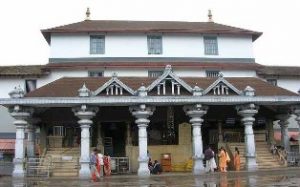
The sacred Dharmasthala Manjunatha Temple exists 75 kilometers east of Mangaluru in the peaceful Western Ghats wilderness. The renowned religious site functions from a main Shaiva perspective through Jain hereditary governance by the Heggade clan who have Madhwa Vaishnavaite clerics taking care of temple religious ceremonies. Dharmasthala stands out as a special place of spirituality because religious traditions successfully merge together here.
Lord Manjunatha serves as the prime deity in a temple which worships his Shiva manifestation. The temple practices Vaishnavite religious procedures while operating under Shaivaite governance because Madhwa priest leadership unites multiple Indian spiritual traditions. For many generations the Heggade family has guided temple administration in its mission of service while maintaining its tradition of philanthropy.
History
- Standing in direct opposition to the temple there exists the Manjusha Museum that showcases an interesting range of artifacts. Visitors at the pilgrimage site and history buffs can examine unique palm-leaf documents and detailed silver jewelry along with religious statues and various art pieces which shed light on the local cultural past.
5.Kukke Subrahmanya Temple

The religious Kukke Subrahmanya Temple stands at 104 kilometers from Mangaluru in Karnataka within an embrace of verdant green hills. This sacred temple maintains great importance for all devotees because it worships Lord Subrahmanya through a serpent deity.
Hindu epics show that the divine snake Vasuki with other serpents found sanctuary in the temple caves where Lord Subrahmanya offered them his spiritual protection. Devotees worship at this temple to receive divine protection against sarpa dosha and other life difficulties because this place holds extensive powers for serpent worship.
Lord Subrahmanya receives unique worship at the temple by being presented in serpentine form because it represents the divine power of the deity. The religious worship includes performing the traditional dance ritual Nagamandala. The Ardhanarishwara aesthetic outfit described as half-man and half-woman costumes allows a dancer to embody cosmic unity through Purusha and Prakruthi forces.
6.Kateel Durga Parameshwari Temple
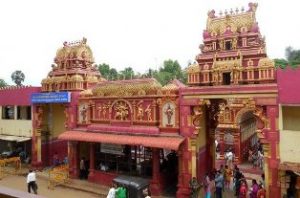
The sacred Durga Parameshwari Temple of Kateel rests 20 kilometers east of Mangaluru where it draws huge numbers of worshippers and visitors. A naturally formed deity of Goddess Durga Parameshwari resides within the temple which stands on an island located in the middle of the sacred Nandini River.
A unique status in Hindu religious tradition belongs to this temple. Durga took her divine presence at this location to stop the devastating behavior of Arunasura the demon according to ancient tales. The house of power for the goddess remains present within the temple which attracts numerous devotees seeking spiritual comfort.
The magnificent architecture stands out as a primary characteristic of Kateel Temple. Viewers can observe elegant columns and elaborate decorations with traditional South Indian temple elements displaying historical cultural traditions of the area. Worshippers along with visitors can find peace in the temple along with its spiritual ambiance which exists within its serene setting.
7.Southadka Sri Ganapathy Temple
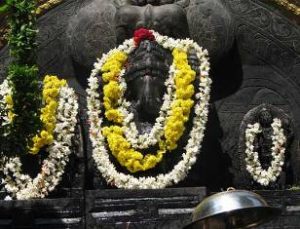
Southadka Sri Ganapathy Temple operates as Sowthadka Temple between Kokkada within Belthangadi Taluk of Dakshina Kannada district in Karnataka. Architecture at this temple is special because Lord Maha Ganapathi finds his place of worship outside temple structures known as ‘Garbha Gudi’ within an open field.
Devotees along with visitors can find peaceful serenity in the temple environment because it is completely surrounded by lush natural vegetation. Devotees experience a mystical connection between divinity and themselves when Lord Ganapathi appears in open skies and this makes the temple a unique sacred location to worship.
Significance
Numerous devotees make their journey to Southadka Temple to receive the blessings of Lord Ganapathi. Visitors can make their prayers at the temple because it maintains an open-round-the-clock policy. Spiritual worship sessions along with specific religious ceremonies take place on a regular basis which establishes an environment of sacred worship.
8.Sri Rajarajeswari Temple
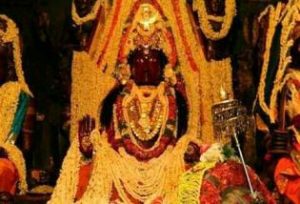
Sri Rajarajeswari Temple in Polali resides peacefully within Karnataka’s landscapes while manifesting divine blessings together with cultural traditions. The temple residence is situated near Kariyangala village that belongs to Bantwal taluk where it faces the Phalguni River. The temple rests in a convenient position that positions it 20 kilometers from both Bantwal and Mangaluru city and 10 kilometers from Mangaluru Airport (Bajpe Airport).
Significance
- The temple of Sri Rajarajeswari Temple stands out because of its spiritual power combined with magnificent architecture. The temple worships Goddess Rajarajeswari as the supreme duty who grants rich blessings and excellent health to praying followers. The temple exists since ancient times and represents remarkable achievements of traditional South Indian temple construction from that period. Visitors find divine charm in the clay idol of Goddess Rajarajeswari because its surface displays unique golden ornaments.
Religious devotees visit the Sri Rajarajeswari Temple in large numbers because they hope to receive blessings from God for good health and prosperity as well as protection. The temple gathers many worshippers who trust that their prayers can clear their way and grant their wishes. A religious tradition of regular poojas and rituals prevails at the temple while generating an extended feeling of devotion among worshippers.
9.Sri Karinjeshwara Temple
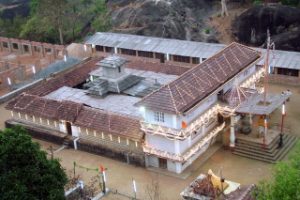
The spiritual landmark named Sri Karinjeshwara Temple exists within Karnataka’s peaceful environment. The traditional temple stands in Karinja village where Kavalamudur belongs to Bantval Taluk and it worships both Lord Shiva and Goddess Parvati. Visitors can reach this temple which stands on a hilltop while enjoying both sacred blessings from the deities as well as spectacular environmental vistas.
The temple stands ready for visitors at 38 kilometers beyond Mangaluru together with 14 kilometers from Bantval. Those seeking to visit the temple should venture from Vagga which stands as a small village on the Mangaluru-Belthangady route. A brief trip by vehicle or a walk of 2 kilometers brings pilgrims to the temple after starting from Vagga.
Significance
- People widely recognize the Karinjeshwara Temple because it provides both serenity and extensive historical significance. Two primary shrines exist at the temple complex because visitors can reach a Lord Shiva sanctuary near its summit while praying at a Goddess Parvati sanctuary closer to the base of the mountain. Shrine visitors at the temple ask for divine grace to bring them better health and financial success and spiritual progress.
10.Anantha Padmanabha Temple
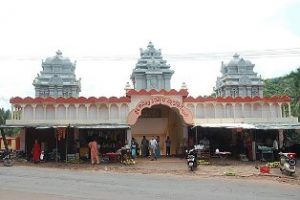
The Kudupu Temple worships Lord Anantha Padmanabha the incarnation of Lord Vishnu and rests 10 kilometers near Mangaluru city along the Mangaluru-Karkala highway. This temple earns its fame through its established historical practices dedicated to serpent worship.
Many devotees make their way to the Kudupu Temple because it maintains significant religious value. The building design together with the peaceful environment at the temple improves the spiritual experience of people who visit. Many devotees choose this holy site to receive blessings that protect them and bring success due to its sacred serpent religious artifacts and Naga-related rituals.
The temple hosts a prominent annual celebration called Shashti which the people celebrate with exceptional pomp. The spiritual event attracts numerous worshippers because they eagerly desire divine blessings from the divine entity. Devotees in large numbers participate in Nagarapanchami to honor serpents with great religious commitment due to its important status. Through these events visitors gain an opportunity to explore the vibrant cultural legacy as well as spiritual wisdom that connects to the temple.
Related articles : Top 2 Best Places Visiting in Chitradurga for History, Nature & Adventure
Stay Informed With the Latest & Most Important News
Previous Post
Next Post
-
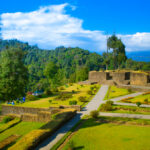 01Top 5 Best Places Visiting in Gyalshing – Monasteries, Lakes & Scenic Escapes
01Top 5 Best Places Visiting in Gyalshing – Monasteries, Lakes & Scenic Escapes -
 02Top 5 Best Places Visiting in Panna – Temples, Waterfalls & Wildlife Escapes
02Top 5 Best Places Visiting in Panna – Temples, Waterfalls & Wildlife Escapes -
 03Top 5 Best Places to Visit in Malerkotla – Malerkotla Fort, Sheesh Mahal & More
03Top 5 Best Places to Visit in Malerkotla – Malerkotla Fort, Sheesh Mahal & More -
 04Top 10 Best Places Visiting in Dakshina Kannad for Culture, Nature & Coastal Charm
04Top 10 Best Places Visiting in Dakshina Kannad for Culture, Nature & Coastal Charm -
 05Top 2 Best Places Visiting in Chitradurga for History, Nature & Adventure
05Top 2 Best Places Visiting in Chitradurga for History, Nature & Adventure -
 06Best Places Visiting in Shopian – Explore Top Attractions & Hidden Gems
06Best Places Visiting in Shopian – Explore Top Attractions & Hidden Gems -
 07Best Places Visiting in Narmadapuram – Temples, Waterfalls & Wildlife Escapes
07Best Places Visiting in Narmadapuram – Temples, Waterfalls & Wildlife Escapes














Pingback: Top 5 Best Places Visiting in Davanagere – Temples, Lakes & Heritage